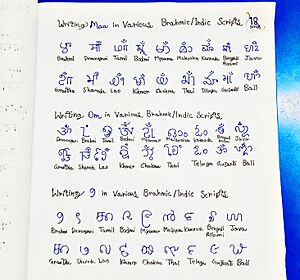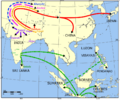Brahmic scripts facts for kids
The Brahmic scripts are a big family of writing systems used across India, Southeast Asia, and parts of East Asia. You might also hear them called Indic scripts. They all come from an ancient Indian writing system called the Brahmi script.
These scripts are used for many different languages. You can find them in languages from families like Indo-Aryan, Dravidian, Tibeto-Burman, and more. Even the way Japanese kana (like hiragana and katakana) are ordered in dictionaries comes from these scripts!
Contents
How Did Brahmic Scripts Start?
Brahmic scripts all grew from the Brahmi script. We know Brahmi was used as early as the 7th century BCE in Tamil Nadu, India.
Over time, Brahmi changed and developed into many different scripts. In northern India, the Brahmi script led to the Gupta script during the Gupta period. This Gupta script then branched out into many other scripts during the medieval period. Some important ones from this time (around the 7th or 8th century) include Nagari, Siddham, and Sharada.
Scientists have many ideas about where Brahmi itself came from. The most common idea is that it came from the Aramaic alphabet, because some of its letters look similar.
The Siddham script was very important for Buddhism. Many holy texts called sutras were written using it. Even today, the art of Siddham calligraphy (beautiful writing) is still practiced in Japan. The way Japanese kana are arranged in order is thought to have come from these Indic scripts, probably through the spread of Buddhism.
In southern India, the Brahmi script changed into scripts like Kadamba, Pallava, and Vatteluttu. These then led to other scripts used in South India and Southeast Asia. Brahmic scripts spread peacefully, often through a process called Indianization. This means Indian knowledge and culture, including writing, spread naturally along trading routes.
Old writings have been found at trading ports in Southeast Asia. At first, these writings were in Indian languages. But later, people started using these scripts to write their own local Southeast Asian languages. By the 8th century, many different local versions of the scripts had developed.
What Makes Brahmic Scripts Special?
Most Brahmic scripts share some cool features:
- Hidden Vowels: Every consonant (like 'k' or 'm') usually comes with a short 'a' sound (like the 'a' in 'about'). This is called an inherent vowel. If you want a different vowel sound, you add a special mark to the consonant.
- No Vowel Sound: Sometimes, you don't want the inherent 'a' sound. There's a special mark called a virama that can be used to show that the consonant has no vowel. But it's not used very often.
- Vowel Forms: Each vowel has two ways it can be written. One way is when it stands alone (like 'A'). The other way is when it's attached to a consonant (like the 'a' in 'cat'). These attached vowel marks can appear to the left, right, above, or below the consonant.
- Joining Consonants: Consonants can be joined together to form special combined letters called ligatures. For example, 'r' often has special ways of combining with other consonants.
- Special Sounds: Marks are also added to show sounds like nasalization (when air comes out of your nose, like in 'ng') or aspiration (a puff of air, like the 'h' in 'hat').
- Alphabetical Order: The letters are always arranged in a specific order: first vowels, then consonants grouped by where they are made in the mouth (like throat sounds, then roof-of-mouth sounds, etc.). Each consonant group usually has four stops (sounds where airflow is completely blocked, like 'p' or 't') and a nasal sound (like 'n' or 'm').
Brahmic Scripts Around the World
Brahmic scripts have spread far and wide, leading to many different writing systems. They are usually divided into two main groups: Northern Brahmic and Southern Brahmic.
Northern Brahmic Scripts
These scripts mostly developed in northern India and then spread to places like Tibet and parts of Southeast Asia.
- Gupta script (4th century): This was a very important script that led to many others.
* Sharada script: Used for Sanskrit and Kashmiri. * Landa scripts: A group of scripts used for business records. * Gurmukhi: Used for the Punjabi language. * Khojki: Used by some Ismaili communities. * Khudabadi: Used by Sindhi communities. * Takri script: Used for languages like Chambeali. * Siddham script (7th century): Important for writing Sanskrit, especially in Buddhism. * Nagari: This script led to many modern Indian scripts. * Devanagari: One of the most widely used scripts today, for languages like Hindi, Marathi, and Sanskrit. * Modi: Used for Marathi in the past. * Gujarati script|Gujarati: Used for the Gujarati language. * Kaithi: Used for legal and administrative records. * Sylheti Nagari: Used for the Sylheti language. * Gaudi script: Another important script that led to Eastern Indian scripts. * Bengali–Assamese script: Used for Bengali and Assamese. * Odia script|Odia: Used for the Odia language. * Tibetan script (8th century): Used for Classical Tibetan and other languages. * Meitei Mayek: Used for the Meitei language. * Lepcha script|Lepcha: Used for the Lepcha language. * Limbu script|Limbu: Used for the Limbu language. * Phags-pa script: Used during the Mongol Yuan dynasty.
Southern Brahmic Scripts
These scripts developed in southern India and spread widely across Southeast Asia, often with the spread of Hinduism and Buddhism.
- Sinhala script (4th century): Used for the Sinhala language in Sri Lanka.
- Kadamba script: An early script from which others developed.
* Telugu-Kannada alphabet: This script split into two major modern scripts. * Telugu script|Telugu: Used for the Telugu language. * Kannada script|Kannada: Used for the Kannada language.
- Tamil-Brahmi (2nd century BC): An early form of Tamil writing.
* Pallava script (6th century): A very influential script that spread across Southeast Asia. * Tamil script|Tamil: Used for the Tamil language. * Grantha script: Used for writing Sanskrit, especially in South India. * Malayalam script|Malayalam: Used for the Malayalam language. * Khmer script|Khmer: Used for the Khmer language in Cambodia. * Thai script|Thai: Used for the Thai language. * Lao script|Lao: Used for the Lao language. * Cham script|Cham: Used for the Cham language. * Kawi script (8th century): An ancient script used across Maritime Southeast Asia. * Balinese script|Balinese: Used for the Balinese language. * Javanese script|Javanese: Used for the Javanese language. * Lontara script|Lontara: Used for the Buginese language. * Baybayin: An ancient script used in the Philippines. * Buhid script|Buhid, Hanunó'o script|Hanunó'o, Tagbanwa script|Tagbanwa: Scripts used for various Philippine languages. * Mon–Burmese script: Led to scripts used in Myanmar. * Burmese alphabet|Burmese: Used for the Burmese language. * Chakma script|Chakma: Used for the Chakma language. * Shan script|Shan: Used for the Shan language. * Tai Tham script: Used for languages like Northern Thai language. * New Tai Lue alphabet|New Tai Lue: A modern script for the Tai Lü language.
- Vatteluttu: Another old script from South India.
Images for kids
-
A piece of Ashoka's 6th pillar edict, written in Brahmi, the original script for all Brahmic scripts.




